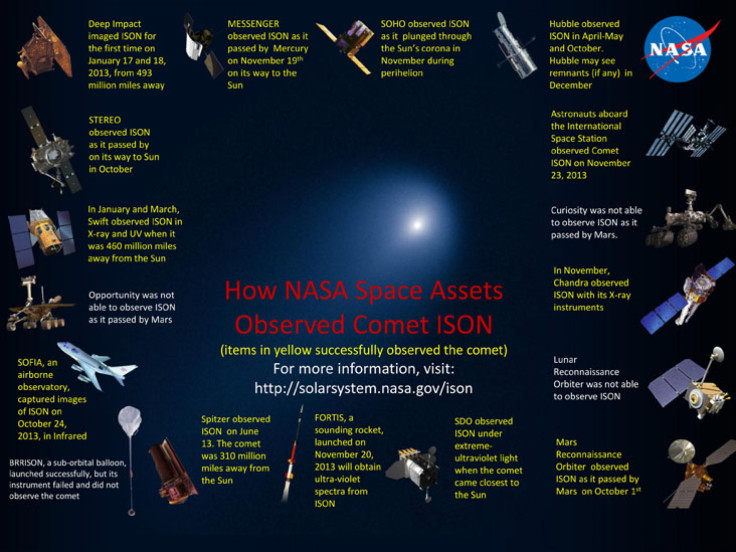What Is Left Of Comet ISON? NASA Begins Search

Just prior to its closest approach to the sun last week, Comet ISON experienced a major heating event that likely caused a severe disruption of the space projectile, and while it is unclear how much of the comet is still intact, NASA has started to look for its remnants.
According to NASA, based on what happened to previous sun-grazing comets, there is a possibility that a sizeable piece of the comet’s nucleus survived the fiery encounter. Many observers also agree that at least 10 percent of the comet is still intact.
“We may be seeing emission from rubble and debris in the comet's trail, along its orbit, or we may be seeing the resumption of cometary activity from a sizable nucleus-sized chunk of ISON,” NASA said in a statement, on Wednesday. “At this point, though, scientists are waiting for a variety of telescopes to make observations before the status of Comet ISON can be confirmed.”
Hours after ISON approached the sun, astronomers witnessed that something shot back into space from the other side of the star. Scientists said that they have seen comets -- such as Comets Lovejoy and Elenin in 2012 -- come close to the sun and disrupt and disappear.
There were also instances when some comets survived in much smaller pieces, such as the Kreutz sungrazer family progenitor and Comet Kohoutek in 1973.
According to NASA, 13 of its spacecrafts and the International Space Station have observed Comet ISON’s journey to the solar corona. Now, the next step for the space agency is to determine and clarify the comet’s current status.
NASA said that it would monitor the comet over the next several weeks, and if nothing sizable and stable was found, it can be concluded that the comet will dissipate and disappear over time. However, according to NASA, if there is still a central source of emission left, scientists may see a new, but much fainter coma and tail form of the comet.
Over the next few days, NASA’s Solar Terrestrial Relations Observatory will be using its cameras to search for bright fragments, while other facilities such as the Infrared Telescope Facility in Honolulu, Hawaii, and other radio telescopes around the world will also participate in the investigation.
In addition, NASA’s recently launched MAVEN spacecraft may try to observe ISON next week. NASA's Hubble and Chandra observatories will also be performing deep outer space searches for any remnants of the comet later this month, while the Spitzer Space Telescope will also look for ISON in early 2014.
Click here for more details about NASA's plan.
© Copyright IBTimes 2024. All rights reserved.












